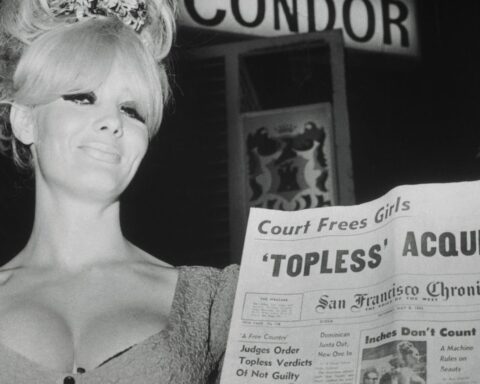Peggy Guggenheim: Art Addict
(USA, 97 min.)
Dir. Lisa Immordino Vreeland
The “mistress of Modern Art” Peggy Guggenheim used to recall to friends and colleagues that she ranked among the poorest members in her phenomenally wealthy family.. In the new documentary Peggy Guggenheim: Art Addict, she tells her biographer Jacqueline Bogard Weld that she only had a fortune of $450 000 growing up, which was a paltry sum for a Guggenheim even in the days preceding the 1920s. This larger than life character and fantastic storyteller, however, adds that her fortune doubled when her mother died and left her nearly five-hundred grand. The arts are forever grateful to what she did with her inheritance.
Peggy Guggenheim: Art Addict unfurls a chic account of the gallerist, collector, patron, and trail-blazing tastemaker who significantly shaped Modern Art. Lisa Immordino Vreeland, director of the film about her mother-in-law Diane Vreeland: The Eye Has to Travel draws ample inspiration from Weld’s book Peggy: The Wayward Guggenheim and structures much of the film around some revealing conversations in previously lost audio recordings from Weld’s interviews with the art heiress. The film covers an impressive range of terrain as it tells Guggenheim’s journey from the cradle to the grave in which she defied convention, lived an eccentric lifestyle, and amassed a landmark collection of art.
The film shows ample prized pieces from Ms. Guggenheim’s collection, if somewhat too fleetingly to appreciate them fully. Immordino Vreeland shows that Guggenheim’s real knack was not for spotting essential artworks, but rather for finding talent. The director uses Guggenheim’s shrewd eye, passion for the arts, and penchant for veering from the mainstream to chronicle the host of artists she fostered in her career. Perhaps most significant among the artists was Jackson Pollock, the abstract expressionist Guggenheim supported both professionally and personally. Before supporting Pollock and to a lesser extent such other adventurous post-World War Two painters as Clyfford Still, Robert Motherwell and Mark Rothko, she had also been a major collector of the Surrealists, especially Max Ernst, with whom she had a short-lived marriage. Long before arts councils gave grants, there was Peggy Guggenheim, and the film voices a chorus of interviewees from the arts community who appreciate her commitment to the arts.
One must admire Guggenheim’s courage to preserve and take risks in a male-dominated field. Especially significant is Immordino Vreeland’s portrayal of Guggenheim’s formative years as an art gallerist, which happened near the onset of World War II. The film lets Guggenheim recount the astonishing story about she amassed a collection of works that are now priceless for the mere collective sum of $40 000 by purchasing paintings by artists who were fleeing the forces of fascism and needed funds to escape. As the film chronicles the growth of the Peggy Guggenheim collection in London, New York, and its eventual home in Venice, it shows how the various forces that cohered into the creation of modern art were empowered and partially sustained by this wealthy aficionado of painting and sculpture.
The film doesn’t interrogate Guggenheim’s place of privilege—many people love the arts, but few people have oodles of money with which to endow starving artists, or the family name/chequebook that lets them build a collection on a gamble—but it’s portrait of the subject isn’t entirely unblemished. The film doesn’t shy away from Guggenheim’s dark side as it acknowledges her failures as a parent and the scandals of her family, including an especially troublesome case in which her sister allegedly dropped her children off the thirteenth floor of a building. Similarly, the film recounts the subject’s countless affairs with artists—from Ernst to Samuel Beckett—and her flair for kissing and telling. As with her efforts in acquiring art, the subject’s personal life ran against convention These revelations don’t simply cater to a warts and all biography; rather, the film uses the complexity of Guggenheim’s life to convey how richly the arts fill voids in an existence and add meaning when one searches for answers.
If fine art is a religion, then Guggenheim amassed a temple of sacred works. The subjects of the film include Robert De Niro (his parents, both artists, showed work with Guggenheim), Marina Abramovic, and Larry Gagosian, and they liken Ms. Guggenheim to a work of art in her own right. A bit like a living, breathing Picasso painting, Peggy Guggenheim is a colourful and peculiar character. One might readily dismiss her upon first glance, but the complexity of her character becomes clearer as one observes her from different perspectives. It’s all in the eye of the beholder.
Peggy Guggenheim: Art Addict is now playing in select theatres.
PEGGY GUGGENHEIM: ART ADDICT (Trailer) from filmswelike on Vimeo.











